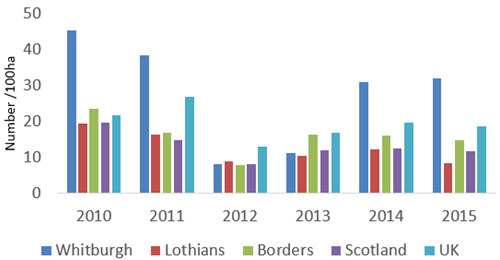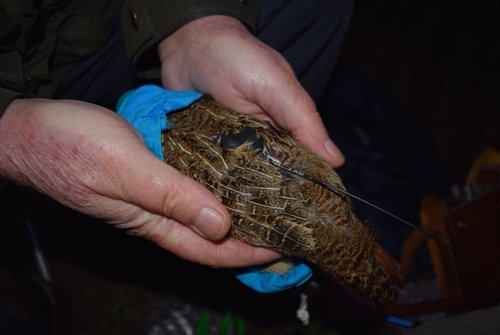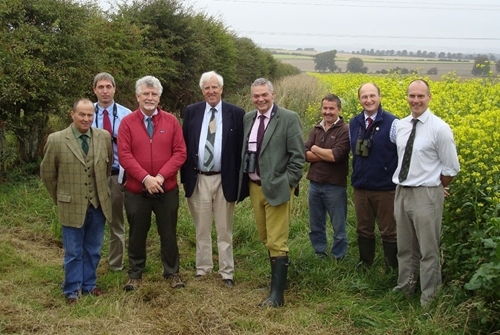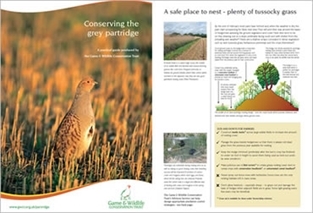Five years of demonstrating grey partridge management at Whitburgh Farms, Midlothian
With the generous support of the owner Alastair Salvesen, the GWCT has been working with the team at Whitburgh Farms for five years to try to demonstrate to key policy makers in Scotland how best to manage lowland farms for the benefit of grey partridge and other wildlife.
Whitburgh is a 1,000 ha predominantly arable farm that had been focusing on grey partridge management for many years before the Trust joined the fray in 2011. Numbers of grey partridge on site have fluctuated over the five years, but are typically above average both locally and nationally (Figure 1). The population was hit particularly badly in 2012 when we experienced an extremely wet and cold summer, followed in 2013 by one that wasn’t that much better, both of which severely curtailed productivity. Thankfully, the Scottish weather has been kinder to us of late and grey partridge numbers are showing signs of recovery.
Figure 1: Autumn densities of grey partridge at Whitburgh in comparison to regional and national trends.

The poor weather of 2012 had an unexpected indirect impact on the birds too: out of 11 radio-tagged hens in that year, all were predated by raptors (based on the signs found on and around the remains). It seemed that the persistent rain was drenching the birds and, in their desperation to dry out, they were exposing themselves to a greater predation risk than normal, coupled with a strong reluctance to return to wet vegetation to seek cover. Indeed, several birds in that year, as well as brown hares, were seen sitting on tracks and at the field edge, and were approachable to within very short distances.
Excluding 2012, raptor predation accounted for a third of deaths amongst radio-tagged hens and led to efforts to quantify the raptor population on site. Detailed surveys in the last two years have shown that buzzards in particular are found in extremely high numbers at Whitburgh – higher than we can find recorded elsewhere in Europe, averaging 1.3 nests per square kilometre.
 A tagged hen grey partridge ready for release. The head is covered to keep her calm.
A tagged hen grey partridge ready for release. The head is covered to keep her calm.
In addition to documenting how the on-site management for grey partridge influences the birds’ behaviour and populations, as well as that of other wildlife like songbirds and brown hare, an extremely important aspect of this project is showing important policy makers from the Scottish Government and Scottish Natural Heritage, plus influential NGOs like the RSPB, not just the benefits of grass margins, cover crops and the like, but also how hard it can be for farmers to successfully produce such habitats. Events at Whitburgh over the five years have established the site as an important place for attracting policy makers to see things ‘on the ground’, with visits from the former Minister for Environment Paul Wheelhouse MSP, senior Scottish Government policy officials Hugh Dignon and Bridget Campbell, and key figures such as Ian Ross of SNH and Stuart Housden of the RSPB.
We have drawn the attention of these visitors to key policy areas such as bird of prey and badger predation on farmland birds, and data from Whitburgh was used in the Understanding Predation report produced recently for Scottish Government. We have also badgered (yes, pun intended!) Scottish Government regarding our belief that policy changes are required to allow farmers to treat weed infestations in game crops so that these areas are able to provide food during the winter months for farmland birds.

Visit to Whitburgh in 2014 by SNH and RSPB. From left: Graham Rankine, Whitburgh gamekeeper; Prof Jerry
Wilson, Head of RSPB Research in Scotland; Ian Ross, SNH Chairman; Alastair Salvesen, Whitburgh owner;
Stuart Housden, Director RSPB Scotland; Jim Nichol, Whitburgh Farm Manager; Dr Adam Smith, Director
GWCT Scotland; Dr Dave Parish, Head of GWCT Lowland Research in Scotland.
Research at Whitburgh has also made important contributions to defending 2m margins for hedgerows in CAP Greening discussions and positively influenced the ability for game crop or wild bird seed mixes to be included under Environmental Focus Areas on fallow, grass margins and buffer strips. It has also helped to develop SNH’s policy on the management of brown hares.
Our work at Whitburgh continues and we hope the next five years will be as productive as the last five!
Get your FREE Grey Partridge Conservation Guide
An essential guide to conserving the grey partridge produced by the Game & Wildlife Conservation Trust.
What's inside your FREE guide
✓ The decline of a common farmland bird
✓ A safe place to nest - plenty of tussocky grass
✓ Chick survival - insect food is crucial
✓ Surviving winter and spring - food and cover
✓ Conservation targets - Partridge Count Scheme
✓ Grey partridges and shooting
✓ Common questions
Download guide now >